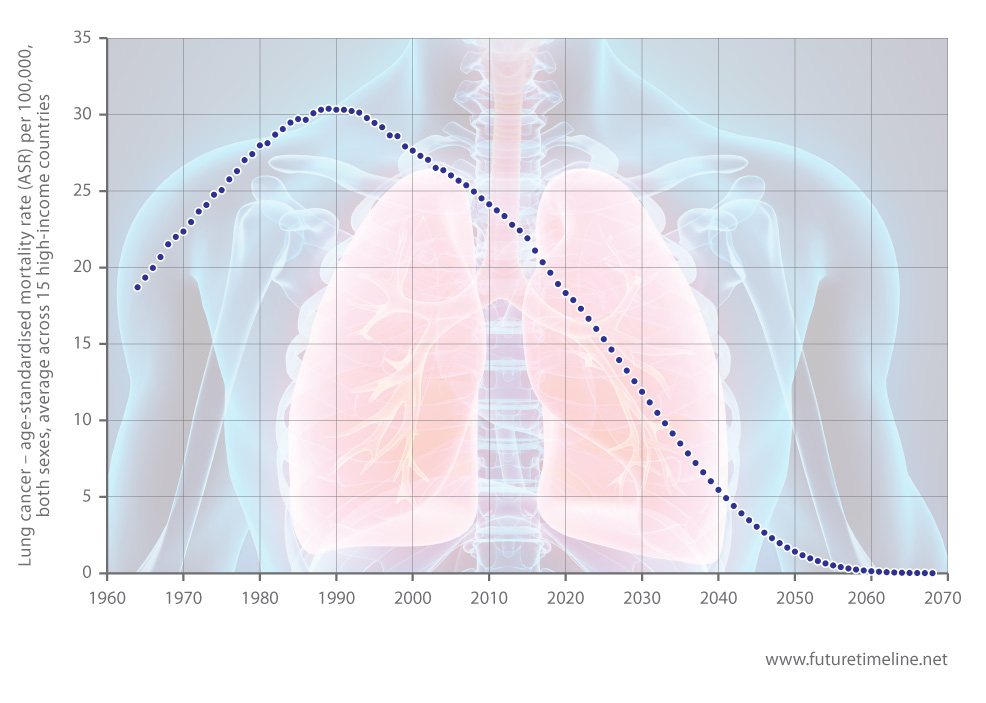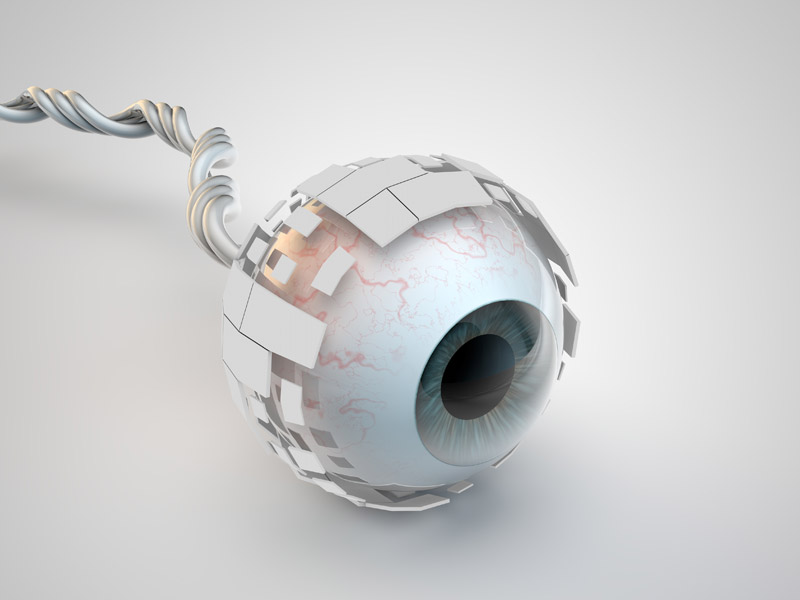
|
|
|
|
|
|
|
2052
Lung cancer mortality falls below 1 per 100,000
Lung cancer, a malignancy that primarily originates from the bronchial cells within lung tissue, once ranked among the most lethal cancers globally. For much of the 20th century, it remained a leading cause of cancer-related death, driven predominantly by tobacco smoking, along with exposure to industrial pollutants and environmental toxins. The disease often appeared late, which significantly complicated treatment and worsened outcomes.
Mortality rates peaked in high-income nations during the late 1980s and early 1990s, reaching 30 deaths per 100,000. Following major public health campaigns, governments implemented strict tobacco regulations and improved diagnostic methods. As a result, both incidence and mortality steadily declined from the late 20th century onwards. This trend accelerated in the 21st century, thanks to breakthroughs in medical imaging, minimally invasive surgery, immunotherapies, and targeted pharmaceuticals.
By 2052, lung cancer mortality in high-income nations has dropped below the critical threshold of 1 per 100,000, signifying the near-elimination of the disease in these leading countries.* Low-dose CT scans – once reserved mainly for high-risk groups – now form a routine part of preventive health checks, being delivered quickly, safely, and at minimal cost. These scans, augmented by AI-driven image recognition algorithms, have greatly improved early detection. Clinicians also use blood-based liquid biopsies – simple blood tests capable of detecting cancer DNA fragments – as standard practice, allowing regular, non-invasive screening across the general population.
Personalised medicine, based on sophisticated genomic sequencing, now routinely identifies molecular markers specific to a patient's tumour, enabling highly customised treatments and dramatically improving outcomes. Immunotherapies, including next-generation checkpoint inhibitors and innovative CAR-T cell therapies tailored for lung cancer, have transformed the therapeutic landscape. These advancements, combined with precision-targeted drugs, have sharply reduced the need for conventional chemotherapy, minimising side effects while maximising efficacy.
Furthermore, surgeons now perform robotic interventions that are precise, safe, and minimally invasive, preserving lung function and ensuring swift recoveries. For early-stage lung cancer, teams routinely use minimally invasive procedures guided by augmented reality, while AI-assisted post-operative monitoring effectively manages recurrence risk.
Public health efforts have sustained the reduction in tobacco use and improved air quality standards. Medical professionals now use precise, molecular-level interventions to bring lung cancer under control, making it a rare diagnosis in the developed world. When detected early, survival rates now approach 100%, reflecting lung cancer's transformation from a feared killer to a highly manageable condition.
While high-income nations have achieved near-elimination, disparities remain in lower-income regions, where tobacco use and limited access to screening continue to pose challenges. Nevertheless, even these countries are beginning to benefit from falling cigarette consumption, expanding healthcare infrastructure, and the global diffusion of low-cost diagnostic tools.
As the world enters the second half of the 21st century, lung cancer is no longer a universal threat but a shrinking shadow of its former self. The transformation from a leading cause of death to a largely preventable and treatable condition stands as a testament to decades of scientific progress – and a reminder of what sustained public health efforts can achieve.

Bionic eyes are perfected
By mid-century, artificial retinas and other visual prostheses can match the visual quality of a real human eye.* The first generation of these devices had emerged in the early 2000s, with bulky external equipment and only a very small number of pixels. Subsequent versions featured much higher resolutions, providing ever-more capabilities to improve the living standard of patients with partial or total blindness.
Further miniaturisation of components in the 2020s and 2030s – combined with advances in materials, optics, and power efficiency – resulted in smoother and more colourful visual experiences, replacing the monotone and blocky view of earlier systems. This progress continued through the 2040s and early 2050s, culminating in electrode arrays with hundreds of megapixels and fully wireless operation.
Myopia and other eye conditions were a growing problem in the early 21st century. Half of the world's population faced living with short sight, with up to one-fifth at significantly increased risk of blindness.* Gene therapy played a vital role in addressing this global issue, but visual prostheses became an increasingly important complement to biological treatments.
By 2052, these implants not only restore sight but also enhance it, offering features such as embedded cameras, Wi-Fi connectivity, augmented reality overlays, and optical zoom. Even healthy adults among the early adopters are beginning to upgrade one or both eyes to benefit from the superior performance of computerised vision.* Such technology had already appeared some years earlier in the military and among elite users, but it is now becoming affordable to the general public.
There are still issues surrounding privacy, security, and ethical use. Some critics warn of the potential for constant surveillance or manipulation of visual data, while others raise concerns about widening inequalities between those who can afford enhancement and those who cannot. Nevertheless, most people view this milestone as a triumph of biomedical engineering – the moment when blindness is effectively eliminated and human vision enters a new, augmented era.

The biggest supermoon of the 21st century
A so-called "supermoon" occurs when a full moon coincides with a lunar perigee – the closest approach of the Moon in its elliptical orbit around Earth. Such events produce the largest apparent size of the lunar disk as seen from Earth, making it appear 15% larger and 30% brighter than during apogee (its most distant point from Earth). This provides great opportunities for astronomers and photographers. Particularly dramatic supermoons occur when a full moon and lunar perigee also happen when Earth is at perihelion (its closest point to the Sun for the year).
On the morning of 14th November 2016, the distance between the centre of the Moon and Earth was 221,524 miles (356,509 km), the closest they had been together during a full moon since 1948. The Moon would not appear this large again until 25th November 2034. The closest supermoon of the century occurs on 6th December 2052.* Notable supermoons are also observed in 2070, 2088 and 2098.

« 2051 |
⇡ Back to top ⇡ |
2053 » |
If you enjoy our content, please consider sharing it:
References
1 Extrapolated from the following dataset, and based on a Gompertz trend.
Age-standardized rate (World) per 100 000, mortality, both sexes, Australia + Austria + Canada + France (metropolitan) + Greece + Hungary + Ireland + Italy + Japan + The Netherlands + Singapore + Spain + Switzerland, United Kingdom, USA – Lung, Cancer Over Time:
https://gco.iarc.fr/overtime/en/dataviz/trends
Accessed 14th August 2025.
2 Bionic eye pixel resolutions, 2000-2050, Future Timeline – Data & Trends:
https://www.futuretimeline.net/data-trends/14-bionic-eye-pixel-resolutions.htm
Accessed 22nd October 2025.
3 Half the world to be short-sighted by 2050, Future Timeline Blog:
https://www.futuretimeline.net/blog/2016/02/22.htm
Accessed 18th August 2019.
4 Tomorrow's bionic eyes will have 'Predator' vision, engadget:
https://www.engadget.com/2019/08/09/Second-sight-orion-bionic-eyes-predator-vision/
Accessed 18th August 2019.
5 Closest supermoon since 1948!, EarthSky:
http://earthsky.org/tonight/closest-supermoon-since-1948
Accessed 20th January 2017.
![[+]](https://www.futuretimeline.net/images/buttons/expand-symbol.gif)






